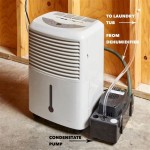Installing a French Drain in Your Basement: A Comprehensive Guide
A French drain is an effective solution for diverting water away from your basement and preventing water damage. Installing a French drain can be a complex task, but by following these steps and consulting with a professional if necessary, you can ensure a successful installation.
Materials Required:
- 4-inch perforated drain pipe
- 4-inch solid drain pipe
- Gravel (3/4-inch size)
- Filter fabric
- Landscape fabric
- Concrete mix
- Masonry nails
- French drain grate
- Utility knife
- Trenching shovel
- Hammer
- Level
- Measuring tape
Steps:
1. Determine the Location of the Drain:
Identify the areas in your basement where water accumulates the most. This will be the starting point for your French drain. The drain should slope away from your house at a rate of 1/4 inch per foot.
2. Dig the Trench:
Excavate a trench along the determined path of the drain. The trench should be 12 inches wide and at least 6 inches deep. The bottom of the trench should be sloped towards the discharge point.
3. Lay the Filter Fabric:
Line the bottom and sides of the trench with filter fabric. This will prevent soil and debris from clogging the drain.
4. Place the Perforated Pipe:
Lay the perforated drain pipe along the bottom of the trench. Secure the pipe in place with masonry nails.
5. Wrap the Pipe with Landscape Fabric:
Wrap the perforated pipe with landscape fabric. This will prevent soil from entering the drain through the perforations.
6. Add Gravel:
Fill the trench with 3/4-inch gravel. The gravel should completely surround the drain pipe.
7. Install the Solid Pipe:
Connect a solid drain pipe to the end of the perforated pipe. This will direct the water away from your house.
8. Create a Discharge Point:
Determine where the water should be discharged, such as a storm drain or a dry well. Connect the solid pipe to the discharge point.
9. Install the French Drain Grate:
Install a French drain grate at the starting point of the drain. The grate will allow water to enter the drain while keeping debris out.
10. Backfill the Trench:
Backfill the trench with the excavated soil or other suitable material. Tamp down the soil to ensure it is compacted.
11. Concrete Collar (Optional):
For added protection, consider creating a concrete collar around the French drain grate. This will help prevent the grate from moving and can improve the overall stability of the drain.
Maintenance:
To ensure the optimal performance of your French drain, regular maintenance is crucial. Clean the French drain grate regularly to remove debris. Additionally, check the discharge point to ensure it is clear and functioning properly.

French Drain Vs Waterguard Interior Drainage System

Basement Sump Pump French Drain Installation Basements Love Us

Dealing With Basement Water From The Inside Greenbuildingadvisor

Thin Floor French Drain System In Philadelphia Baltimore Ellicott City Pa De And Md Installation Pennsylvania Delaware Maryland

Is A French Drain The Solution For Wet Crawl Space Seattle Times

French Drain Installation Basement Lifeguard Waterproofing

Footing Drain Interior French Pros And Cons Sani Tred

French Drain Installation Ny And Pa 877 885 2268 Vulcan Basement Waterproofing

French Drain For A Basement Toms River Patch

Interior Basement Drainage In Pennsylvania Drain System Installed Along The Perimeter Pa
See Also








